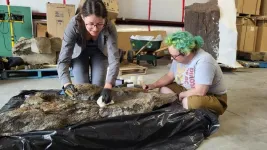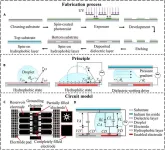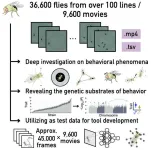(Press-News.org) New tool for cutting DNA: promising prospects for biotechnology
An INRS team discovers a new family of enzymes capable of inducing targeted cuts in single-stranded DNA
A few years ago, the advent of technology known as CRISPR was a major breakthrough in the scientific world. Developed from a derivative of the immune system of bacteria, CRISPR enables double strands of nucleotides in deoxyribonucleic acid (DNA) to be cut. This makes it possible to specifically modify a targeted gene in plant, animal and human cells. Ultimately, CRISPR became a preferred method in the search for treatments for acquired or hereditary diseases.
Recently, Professor Frédéric Veyrier at the Institut national de la recherche scientifique (INRS) and his team developed a new genetic tool based on a family of specific enzymes called Ssn that allows targeted cuts to be induced exclusively in single-stranded DNA.
The results of their work were recently published in the journal Nature Communications. This major breakthrough sheds light on a crucial genetic mechanism that could revolutionize a multitude of biotechnology applications.
A form of DNA with a key role
Single-stranded DNA is less common than double-stranded DNA. It is often found in some viruses and plays a key role in certain biological processes, such as cell replication or repair. Single-stranded DNA is also used in many technologies (sequencing, gene editing, molecular diagnostics, nanotechnology).
To date, no endonuclease – enzyme that cuts DNA – has been described as exclusively targeting a single-stranded DNA sequence, which has constituted a barrier to the development of technologies based on this type of DNA.
Now, for the first time in a laboratory, Professor Veyrier’s team has identified a family of enzymes capable of cutting a specific sequence in single-stranded DNA: the family of Ssn endonucleases.
To achieve this, the research team at INRS’s Armand-Frappier Santé Biotechnologie Research Centre first characterized a new family of endonucleases part of the GIY-YIG superfamily called Ssn. More specifically, researchers focused on one of these enzymes in the bacterium Neisseria meningitidis, also known as the meningococcus. The enzyme targeted in the study is crucial to the exchange and alteration of genetic material, which influences evolution.
“In studying it, we found that it recognizes a specific sequence that is found in many instances in its genome and plays a key role in the natural transformation of the bacterium. This interaction directly influences the dynamics of the bacterial genome,” explains Professor Veyrier, a specialist in genomic bacteriology and evolution.
In addition to this fundamental discovery, INRS’s research scientists identified thousands of other similar enzymes. “We demonstrated that they are able to recognize and specifically cut their own single-stranded DNA sequence. Thousands of enzymes therefore have this property with their own specificity,” adds Alex Rivera-Millot, a postdoctoral fellow on Professor Veyrier’s team and co-first author of the study.
Artwork depicting various sequences of single-stranded DNA being cleaved by distinct bacterial homologs of the novel Ssn enzyme family.
Credit: Ella Maru Studio
An undeniable asset for health research
These results, which represent a new tool for DNA recognition and exchange, are significant. They pave the way to many novel applications in biology and medicine. On the one hand, understanding this mechanism could help better control the bacteria in question and the associated infections.
On the other, the discovery of enzymes specific to single-stranded DNA makes it possible to develop more precise and efficient genetic manipulation tools. This could namely improve methods of gene editing, DNA detection and molecular diagnosis. These enzymes could also be used to detect and manipulate DNA in various medical and industrial applications, such as pathogen detection or genetic manipulation for medical and therapeutic purposes.
All of these avenues hold significant promise for addressing many health issues. Currently, there is a patent pending for the results of this work.
About the study
Chenal, M.*, Rivera-Millot, A.*, Harrison, L.B. et al. Discovery of the widespread site-specific single-stranded nuclease family Ssn. Nat Commun 16, 2388 (2025). https://doi.org/10.1038/s41467-025-57514-1.
This work was funded by the Natural Sciences and Engineering Research Council of Canada (NSERC), the Canadian Institutes of Health Research (CIHR) and the Fonds de recherche du Québec – Santé (FRQS).
END
New tool for cutting DNA: Promising prospects for biotechnology
An INRS team discovers a new family of enzymes capable of inducing targeted cuts in single-stranded DNA
2025-04-14
ELSE PRESS RELEASES FROM THIS DATE:
Footprints of tail-clubbed armored dinosaurs found for the first time
2025-04-14
Victoria, BC— For the first time, footprints of armoured dinosaurs with tail clubs have been identified, following discoveries made in the Canadian Rockies. The 100-million-year-old fossilized footprints were found at sites at both Tumbler Ridge, BC, and northwestern Alberta.
There are two main groups of ankylosaurs. Nodosaurid ankylosaurs have a flexible tail and four toes, while ankylosaurid ankylosaurs have a sledgehammer-like tail club, and only three toes on their feet.
Unlike the well-known ankylosaur footprints called Tetrapodosaurus ...
Structural optimization of microfluidic chips for enhancing droplet manipulation and observation via electrodynamics simulation
2025-04-14
A research paper by scientists at Beijing Institute of Technology and City University of Hong Kong presented a versatile electrodynamics simulation model designed to analyze the driving forces of partially filled electrodes to optimize the structural parameters of Digital microfluidic chips.
The research paper, published on Mar. 06, 2025 in the journal Cyborg and Bionic Systems, utilizes finite element analysis to determine the voltage distribution within the Digital microfluidic chip and calculates the driving force acting on the droplets using the principles of virtual work.
Digital microfluidic chips (DMCs) have shown huge potential for biochemical analysis ...
Stress, depression factor into link between insomnia, heavy drinking
2025-04-14
COLUMBUS, Ohio – Insomnia and hazardous drinking are so closely intertwined that estimates suggest at least one-third, and as many as 91%, of people who have a hard time with sleep also misuse alcohol.
A new study suggests that perceived stress and depression factor into the relationship between the two conditions – perhaps not a surprise. But because the relationship between insomnia and heavy drinking goes in both directions, the influence of stress or depression depends on which condition came first, the analysis found.
“We were most interested in how insomnia leads to drinking, and we found that seems to occur primarily through ...
Unlocking the genetic basis of animal behavior using fruit flies
2025-04-14
Years of research in the field of genetics have offered interesting insights spanning the origins and development of heredity and traits, offering valuable information on its influence on every aspect of life, right from eye color to susceptibility to certain diseases. But how do our genes influence the way we act, react to threats, and interact with others? Despite the recent advances in genetics, understanding the genetic foundations of behavior remains one of biology’s most fascinating challenges. Scientists have long turned to simpler organisms to help answer these questions, with the humble fruit fly emerging as an ideal candidate. These tiny insects share ...
New AASM position statement highlights the clinical significance of sleepiness and its impact on health and safety
2025-04-14
DARIEN, IL — The American Academy of Sleep Medicine has released a new position statement emphasizing the clinical significance of sleepiness and its impact on performance, health, mood, safety, and quality of life.
The position states that sleepiness is a critical patient-reported outcome that is associated with an increased risk for adverse health effects and diminished quality of life. The statement urges health care professionals, policymakers, and researchers to prioritize the evaluation, management, and treatment of sleepiness ...
USC scientists find a gut-brain link that may affect behavior in children with autism
2025-04-14
A new USC study suggests that gut imbalances in children with autism may create an imbalance of metabolites in the digestive system — ultimately disrupting neurotransmitter production and influencing behavioral symptoms.
The research, published today in Nature Communications, adds to a growing body of science implicating the “gut-brain” axis in autism. The discovery raises the possibility of new treatment avenues. It’s an example of how research at USC, and other universities, drives ...
Pioneering research reveals Arctic matter pathways poised for major shifts amidst climate change
2025-04-14
A new study has shed unprecedented light on the highly variable and climate-sensitive routes that substances from Siberian rivers use to travel across the Arctic Ocean. The findings raise fresh concerns about the increasing spread of pollutants and the potential consequences for fragile polar ecosystems as climate change accelerates.
The international research, published today in Nature Communications and led by the University of Bristol, in the UK, provides the clearest ever picture of how the underlying transport system, known as the Transpolar Draft, operates. It also uncovers the various factors controlling this major Arctic surface current, ...
Scientists may have solved a puzzling space rock mystery
2025-04-14
An international team of researchers may have answered one of space science’s long-running questions – and it could change our understanding of how life began.
Carbon-rich asteroids are abundant in space yet make up less than 5 per cent of meteorites found on Earth.
An international team of scientists from Curtin University’s School of Earth and Planetary Sciences, the International Centre for Radio Astronomy (ICRAR), the Paris Observatory and more scoured the globe to find an answer.
Published today in Nature Astronomy, researchers analysed close to 8500 meteoroids and meteorite impacts, using data from ...
Sleep matters: Duration, timing, quality and more may affect cardiovascular disease risk
2025-04-14
Statement Highlights:
While the strongest evidence exists that getting sufficient sleep (duration of sleep) is important for overall health , other components of sleep health, such as consistent bedtime, uninterrupted sleep, daytime functioning and self-reported sleep satisfaction, also contribute to cardiometabolic health and related risk factors, including heart disease, stroke, high blood pressure, high cholesterol, inflammation, glucose intolerance, obesity and obstructive sleep apnea.
Differences in sleep health may contribute to increased risk factors and worse health outcomes, particularly for people in under-resourced communities and individuals ...
Light bulb moment for understanding DNA repair switches
2025-04-14
Researchers from the University of Birmingham have uncovered answers that provide the detail to explain two specific DNA repair processes that have long been in question.
The publication of two papers demonstrates how work led by laboratories from the Department of Cancer and Genomic Sciences, and School of Biosciences at the University of Birmingham has made strides in understanding how the repair process is correctly orchestrated.
The importance of understanding DNA repair
Our cells protect their DNA by constantly monitoring and repairing any damage. When DNA is damaged, internal signals activate within the cell to pinpoint the damage and recruit specialised proteins—DNA ...
LAST 30 PRESS RELEASES:
Palaeontology: Ancient tooth suggests ocean predator could hunt in rivers
Polar bears may be adapting to survive warmer climates, says study
Canadian wildfire smoke worsened pediatric asthma in US Northeast: UVM study
New UBCO research challenges traditional teen suicide prevention models
Diversity language in US medical research agency grants declined 25% since 2024
Concern over growing use of AI chatbots to stave off loneliness
Biomedical authors often call a reference “recent” — even when it is decades old, analysis shows
The Lancet: New single dose oral treatment for gonorrhoea effectively combats drug-resistant infections, trial finds
Proton therapy shows survival benefit in Phase III trial for patients with head and neck cancers
Blood test reveals prognosis after cardiac arrest
UBCO study finds microdosing can temporarily improve mood, creativity
An ECOG-ACRIN imaging study solves a long-standing gap in metastatic breast cancer research and care: accurately measuring treatment response in patients with bone metastases
Cleveland Clinic presents final results of phase 1 clinical trial of preventive breast cancer vaccine study
Nationally renowned anesthesiology physician-scientist and clinical operations leader David Mintz, MD, PhD, named Chair of the Department of Anesthesiology at the UM School of Medicine
Clean water access improves child health in Mozambique, study shows
Study implicates enzyme in neurodegenerative conditions
Tufts professor named Fellow of the National Academy of Inventors
Tiny new device could enable giant future quantum computers
Tracing a path through photosynthesis to food security
First patient in Arizona treated with new immune-cell therapy at HonorHealth Research Institute
Studies investigate how AI can aid clinicians in analyzing medical images
Researchers pitch strategies to identify potential fraudulent participants in online qualitative research
Sweeping study shows similar genetic factors underlie multiple psychiatric disorders
How extreme weather events affect agricultural trade between US states
Smallholder farms maintain strong pollinator diversity – even when far from forests
Price of a bot army revealed across hundreds of online platforms worldwide – from TikTok to Amazon
Warblers borrow color-related genes from evolutionary neighbors, study finds
Heat signaling from plants is an ancient pollinator signal
New index reveals the economics underlying the online manipulation economy
High-resolution satellite observations reveal facility-level methane emissions worldwide
[Press-News.org] New tool for cutting DNA: Promising prospects for biotechnologyAn INRS team discovers a new family of enzymes capable of inducing targeted cuts in single-stranded DNA




